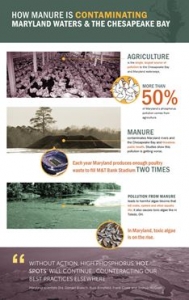Advocates Say New Rule to Limit Manure Represents Biggest Opportunity for Clean Water in 30 Years
FOR IMMEDIATE RELEASE
November 7, 2014
Contact: Dawn Stoltzfus, The Hatcher Group, (410) 990-0284
(Annapolis, MD) – A Salisbury University economic study shows a new rule to better manage manure would be comparable to, or cost less than, other Chesapeake Bay pollution-reduction efforts, said a coalition of nonprofit organizations working to reduce pollution and increase transparency from agriculture. The study provided an overall cost estimate for the agricultural industry to implement the Phosphorus Management Tool (PMT) using a phased-in approach, which advocates say shows the new rule is workable.
The science-based PMT would reduce pollution by limiting manure applied to farm fields already contaminated with excess phosphorus levels. The rule would improve water quality, protect public health reduce harmful algae blooms.
“Phosphorus pollution from manure is getting worse, not better in the Chesapeake Bay and Maryland waterways. If this continues, Maryland will jeopardize the decades of progress we’ve made to clean up our waters,” said Joanna Diamond of Environment Maryland.
Experts say the new manure rule is one of the biggest opportunities to clean up the Chesapeake Bay and local waters in more than 30 years.
“It is past time to stop studying this issue and time to start acting,” said Bob Gallagher, of West/Rhode Riverkeeper, Inc. “Rarely can a single initiative achieve such huge pollution reductions in one fell swoop. The new phosphorus rule, like the phosphorus detergent ban of the 1980s, is one of those opportunities to really make a difference.”
When compared to other pollution reduction measures, the cost per pound to reduce phosphorus using the PMT is roughly on par with other investments like cover crops and upgrades to wastewater treatment plants.
For example, one of the most cost effective agricultural practices is planting grass buffers on agricultural lands. Using grass buffers to reduce 48,000 pounds of phosphorus would cost about $12 million per year. Upgrades to wastewater treatment plants expected to reduce 48,000 pounds of phosphorus would cost about $14.9 million each year. According to the study, investing $3.75 million annually to implement the PMT over six years will cost $22.5 million and would reduce 228,000 pounds of chicken litter, which the Chesapeake Bay Program estimates would reduce 48,000 pounds of phosphorus annually.
In 2013, Maryland’s poultry industry made $804 million in revenue. Advocates say the industry needs to help fund pollution clean-up costs and not expect small farmers or taxpayers to pay the full tab.
“This study shows the new phosphorus rule is workable – it’s a question of finding the right way to implement it,” said Karla Raettig of the Maryland League of Conservation Voters. “Cleaning up waterways that suffer from manure pollution must be a top priority for everyone, including poultry processors. They need to play a greater role in the solution. Our waters, our public health and our economy depend on it.”
Advocates also cited concerns about continued delays to reduce phosphorus pollution, even as the state finalizes a renewed permit for concentrated animal feeding operations and counties approve hundreds of new, industrial-sized poultry houses on Delmarva.
“While Maryland continues to delay this much-needed rule to better manage manure, the large-scale poultry industry – and the tons of waste it produces – continue to rapidly expand,” said Kathy Phillips, Assateague Coastkeeper. “It makes no sense for Maryland to produce tons more manure until we have a plan to safely handle it and protect our waters.”
A recent report by the Environmental Integrity Project showed no improvement in phosphorus levels in eight major rivers on Maryland’s Eastern Shore over ten years, with pollution actually worsening in the Nanticoke, the Sassafras and the Transquaking Rivers.
In June, the Baltimore Sun reported on another study that concluded phosphorus produced by the Maryland poultry industry is increasing because of larger birds that produce more waste, and that phosphorus pollution has remained unchanged in nearly two-thirds of the rivers and streams tested and worsened in 16 percent.
Maryland’s 2010 Chesapeake Bay Watershed Implementation Plan (WIP) committed the state to updating the Phosphorus Management Tool in 2011. However, the regulations have been repeatedly delayed due to political objections from agricultural industry lobbyists and pressure from legislative leaders. A study by the Chesapeake Bay Foundation found that failure to fully implement Maryland’s plan to restore the Chesapeake Bay would result in a $700 million annual loss.
According to BayStat, agriculture is the single, largest source of pollution to the Chesapeake Bay and Maryland waterways, and more than half of Maryland’s phosphorus pollution comes from farms. Phosphorus pollution causes algae blooms that threaten public health; kill underwater grasses; harm aquatic life like blue crabs, oysters and fish; and create an enormous “dead zone” in the Bay.
Read a fact sheet for more information about the Phosphorus Management Tool.
###
The Maryland Clean Agriculture Coalition is working to improve Maryland waterways and protect public health by reducing pollution, and increasing transparency and accountability, from agriculture and other associated sources of water degradation.
Anacostia Riverkeeper – Audubon Naturalist Society – Assateague Coastal Trust – Blue Water Baltimore – Chesapeake Climate Action Network – Clean Water Action – Common Cause Maryland – Environment Maryland –League of Women Voters of Maryland – Lower Susquehanna Riverkeeper – Maryland League of Conservation Voters – Maryland Pesticide Network – National Wildlife Federation, Mid-Atlantic Regional Center – Potomac Riverkeeper – Sierra Club, Maryland Chapter – South River Federation – Waterkeepers Chesapeake – West/Rhode Riverkeeper
Download this press release (PDF)

